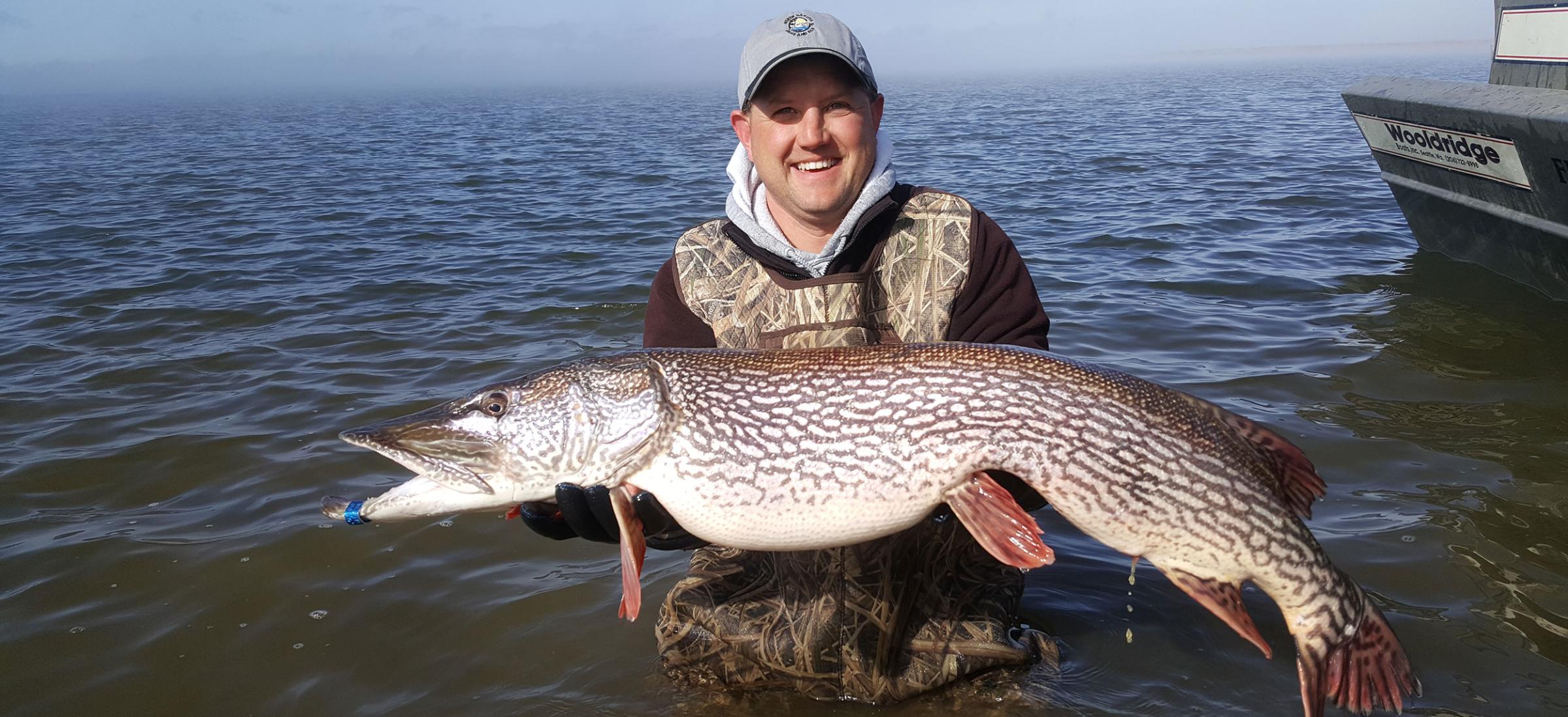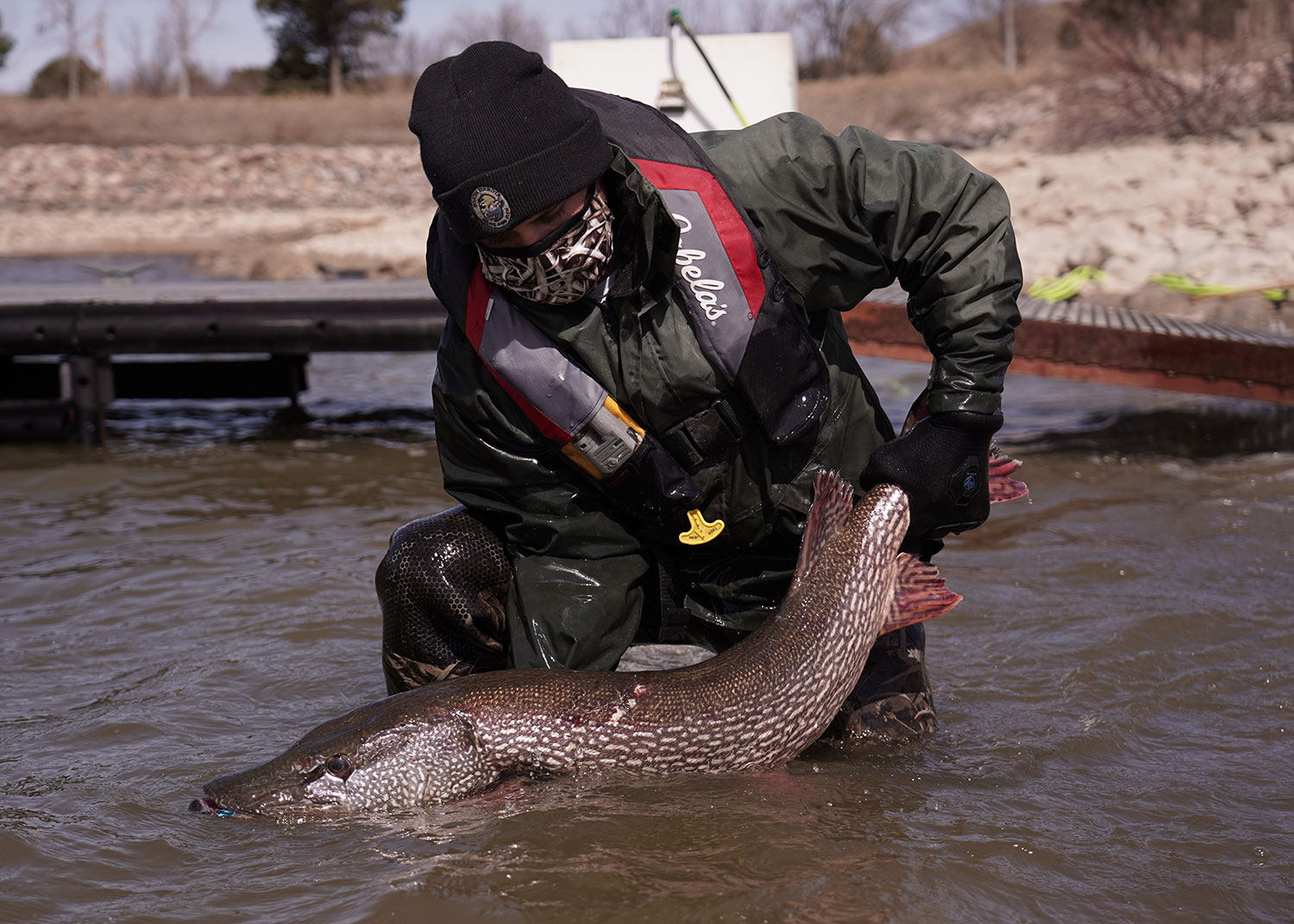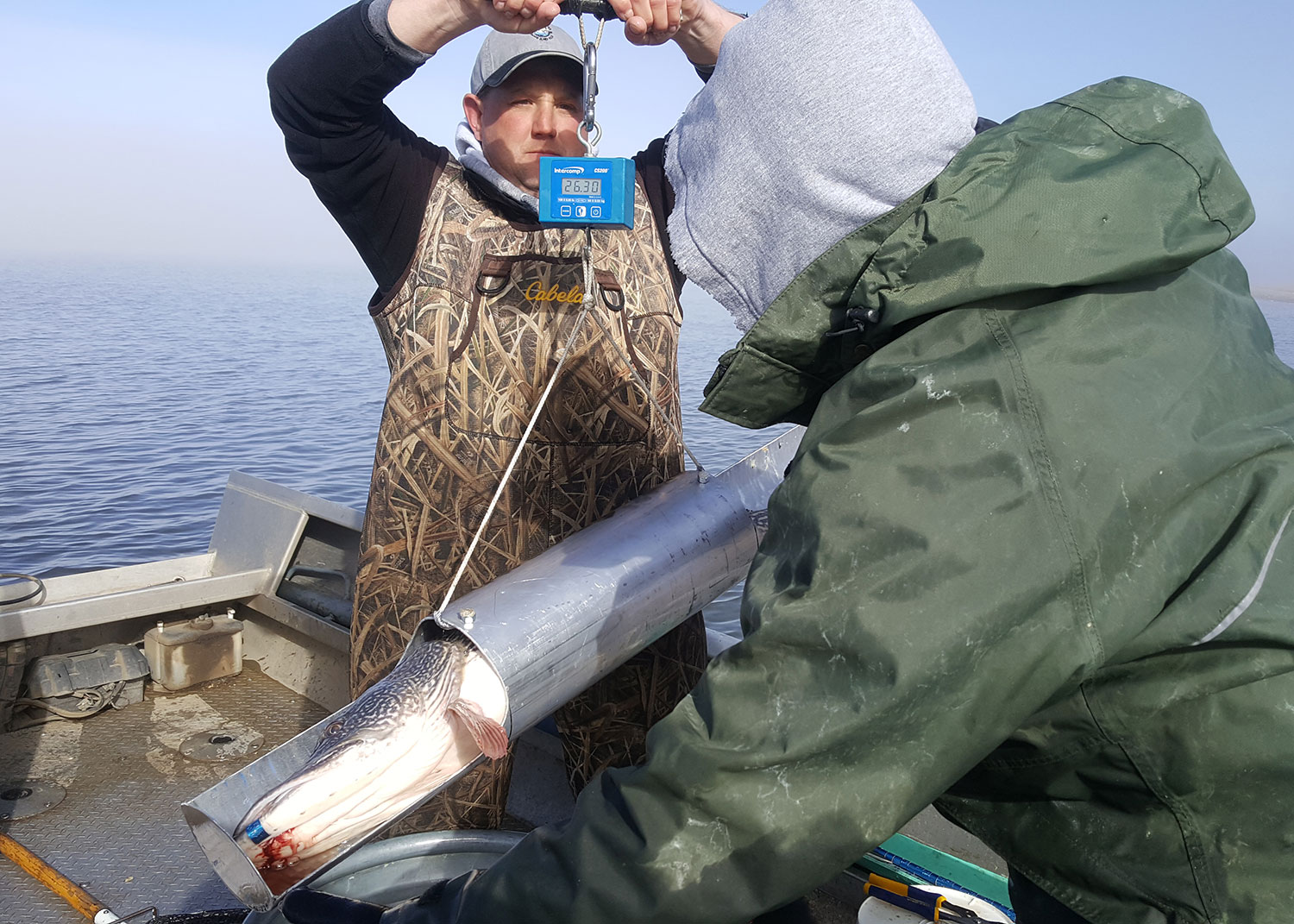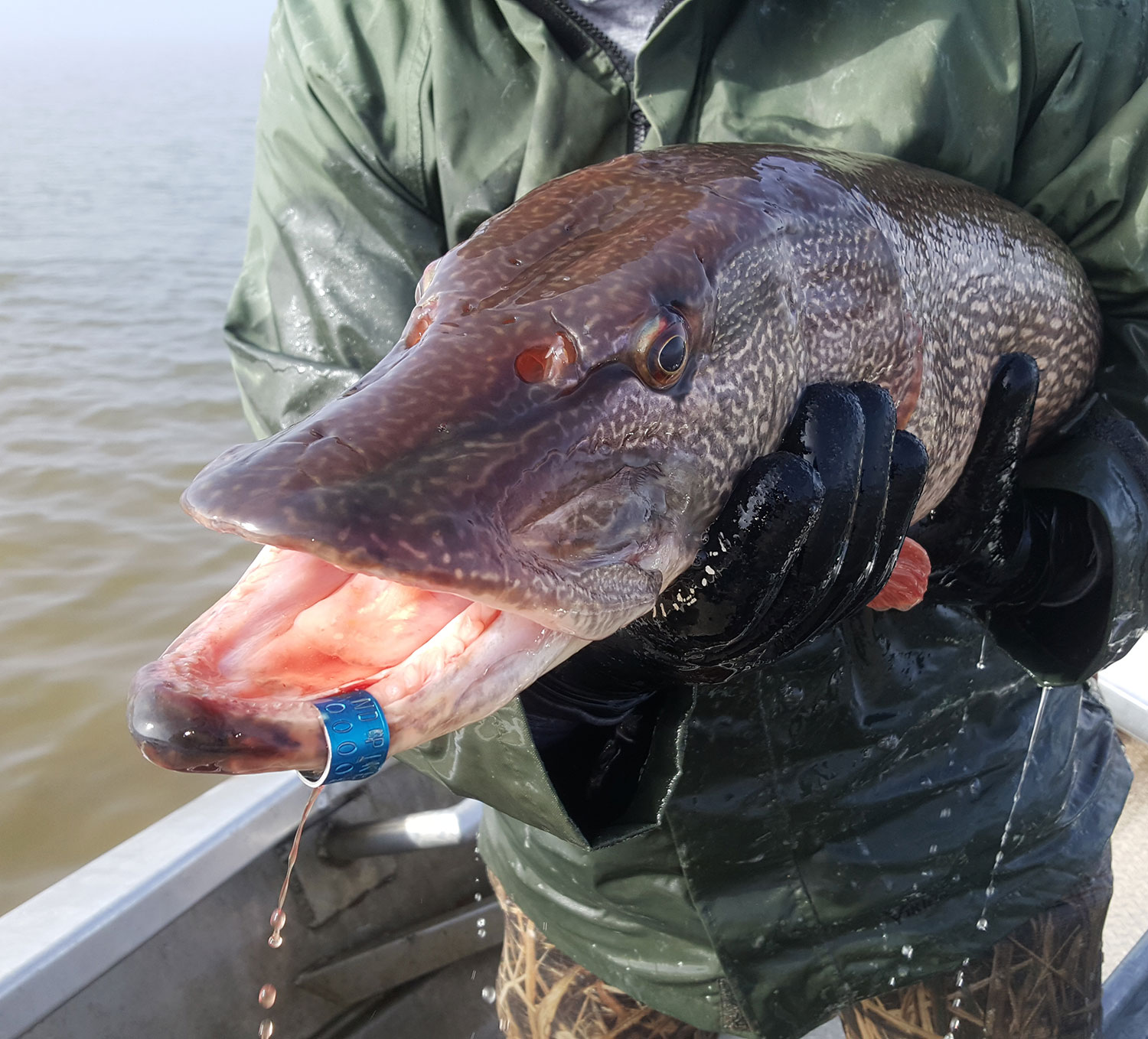Walleye are certainly king in North Dakota but there are extraordinary fishing opportunities for many other species within our state’s borders. The Red River is world-renowned for its channel catfish. Lakes Audubon and Spiritwood offer some of the best smallmouth bass fishing anglers could ever hope to find. Our prairie pothole lakes provide countless perch dinners. Add in bluegill, crappie, largemouth bass, paddlefish, white bass, muskie and a host of other species among our 400-plus fishing waters, and it is easy to see that anglers will run out of time before running out of fishing opportunities.
Targeting large northern pike on North Dakota’s two Missouri River System reservoirs, Lake Sakakawea and Lake Oahe, presents one of our state’s most unique and spectacular angling opportunities. Construction of Garrison Dam was completed in 1953, followed by Oahe Dam in 1958, and as these reservoirs filled throughout the 1960s, they provided the environmental conditions northern pike need to grow to trophy sizes.
Recipe for Trophy Pike
Our shallow prairie lakes support many excellent pike fisheries. However, northern pike tend to have a live-fast and die-young life history in these environments. Warm summer water temperatures and forage dominated by aquatic insects, fathead minnows and yellow perch can lead to fast growth of young pike, but these conditions seldom result in pike living beyond 5 or 6 years or surpassing 8 to 10 pounds.
Conversely, the deeper waters of lakes Sakakawea and Oahe offer cooler summer water temperatures that large female pike prefer, as well as a diversity of forage necessary to support pike of all sizes. This combination allows pike to live long and grow big.
In fact, the Missouri River System has accounted for approximately 80% of the 20-pound and larger northern pike submitted to the North Dakota Game and Fish Department’s Whopper Club since the program’s inception in 1960. Many dedicated Sakakawea and Oahe walleye anglers have encountered a whopper pike whether they wanted to or not. Fish of 25 pounds are reported with some regularity and several 30-plus-pound pike have been confirmed over the years.
These pike fisheries are clearly something special. They have a dedicated following among our resident anglers and have become destination fisheries for many nonresidents as well. Anglers are understandably interested in maintaining the angling opportunity for these trophy fish and we, as both fisheries biologists and passionate pike anglers ourselves, feel the same.
The amount of water that Mother Nature provides and how that water is managed by the U.S. Army Corps of Engineers is the primary factor governing the quality of the Lake Sakakawea and Lake Oahe fisheries, northern pike included. However, angler use of these pike through angling harvest, spearing and catch-and-release are also important considerations. We undertook a northern pike tagging study to gain a better understanding of how anglers are utilizing these fish and to ensure that suitable regulations are in place to maintain this opportunity for years to come.
Angler Use
Both Lake Sakakawea and Lake Oahe have frequently been used as sources of northern pike and walleye eggs to produce fingerling fish at Garrison Dam and Valley City national fish hatcheries to meet stocking needs around the state. We use trap nets to collect fish for spawning purposes each spring and frequently encounter trophy-sized northern pike when doing so. This provided us with the opportunity to tag many trophy northern pike without adding significantly more work to our very busy spring schedules. For the purpose of this study, we defined a trophy northern pike as a fish 1 meter in length (39.4 inches) or longer.
Tagging began in the spring of 2017 and continued through the spring of 2021. In total, we tagged 665 trophy northern pike in the Missouri River System (341 in Lake Sakakawea and 324 in Lake Oahe). Every pike collected was a female with the largest being a 29.7-pound fish from Lake Oahe.
Fisheries biologists generally assess fish harvest as an annual rate in much the same way you may be interested in the annual interest rate of a home or auto loan from your bank or annual rate of return from your retirement savings. Thus, assessing the number of pike harvested within the first year of being tagged provided us the annual rate of harvest, which is one of the most important pieces of information from this study.
Anglers reported harvesting 33 tagged northern pike on Lake Sakakawea within their first year of tagging and nine additional fish were reported as speared. This yields an annual harvest rate of 12.3%. Anglers also reported catching and releasing 15 of these big pike within their first year of being tagged.
For Lake Oahe, anglers reported harvesting 23 tagged northern pike within their first year of tagging and one additional fish was reported as speared. This yields an annual harvest rate of 7.4%. Anglers also reported catching and releasing 31 of these fish within their first year of being tagged.
Acceptable Harvest Level?
Anglers have enjoyed using the Lake Sakakawea and Lake Oahe trophy northern pike fisheries for 60-plus years and any reasonable angler is likely to agree that some use of those fish is acceptable, whether that use is through angling harvest, spearing, or catch-and-release (which certainly kills some additional fish). We have identified that anglers are harvesting 12.3% of Lake Sakakawea’s trophy northern pike and 7.4% of Lake Oahe’s trophy northern pike annually, but are these harvest rates sustainable?
Unfortunately, little research has been conducted on sustainable harvest rates for trophy northern pike populations. However, more extensive research has been conducted on muskellunge, a close relative. In a study of muskellunge populations across their entire North American range, researchers suggested that the annual harvest rate should not exceed the natural mortality rate (rate of mortality from everything other than angler harvest such as old age, disease and predation) to ensure sustainability of trophy muskellunge fisheries. This is reasonable guidance to apply to our trophy Missouri River System northern pike fisheries given their similarities to trophy muskellunge fisheries.
Information collected by the North Dakota Game and Fish Department indicates that Lake Sakakawea’s northern pike have a natural mortality rate of 15.7%, a number the current harvest rate (12.3%) falls comfortably below. Likewise, Lake Oahe’s northern pike have a natural mortality rate of 20.3%, a number the current harvest rate (7.4%) also falls well below.
Together, this information indicates that the ways in which anglers are currently using the Lake Sakakawea and Lake Oahe trophy northern pike fisheries are compatible with their long-term sustainability. This also indicates that our current northern pike harvest regulations (5 fish daily; 10 in possession) are appropriate for these fisheries.
This is great news for these trophy northern pike fisheries and for the anglers who enjoy the opportunities that they provide.
BIG, OLD FISH
By Ron Wilson
We know the fish tagged in a years-long study to recognize how anglers utilize trophy northern pike in the Missouri River System are big.
To be study worthy, and receive a blue, metal jaw tag, pike had to measure 39.4 inches, or 1 meter. What we didn’t know, as anglers casting dead smelt from shore after ice-out or fishing from a boat, is the age of these fish that are all big enough to swallow small mammals.
“It typically takes these fish 10 to 11 years to hit that 1-meter-long size,” said Paul Bailey, Department fisheries supervisor in Bismarck. “We’re estimating the maximum age of a pike in Lake Oahe to be about 15 years old.”
For perspective, that means a trophy northern pike that lives to that maximum age and goes belly-up today was hatched in 2007. For more perspective, and if you can hark that far back, that was the year the first smartphone was made available to the public.
Also of note, of the nearly 700 pike from lakes Sakakawea and Oahe netted and tagged for the study, more than 40 were later caught and released by anglers with the tag still attached.
Dave Fryda, Department Missouri River System supervisor in Riverdale, said 19 pike were caught and released by anglers with the tags still attached. Of those, six were caught a second time by anglers.
For Oahe, Bailey said 26 were caught and released by anglers with the tags still attached, and five of those were caught a second time by anglers.
Also of interest, eight of the hundreds of study pike were found dead, washed up on shore by passersby.
“These fish were found by people walking the shoreline while fishing or recreating on Lake Oahe and Sakakawea,” Bailey said. “They were simply just walking along and found a big, dead pike that still had a tag in its jaw and reported it to us. This indicates that a fair number of these fish are simply dying of old age.”





